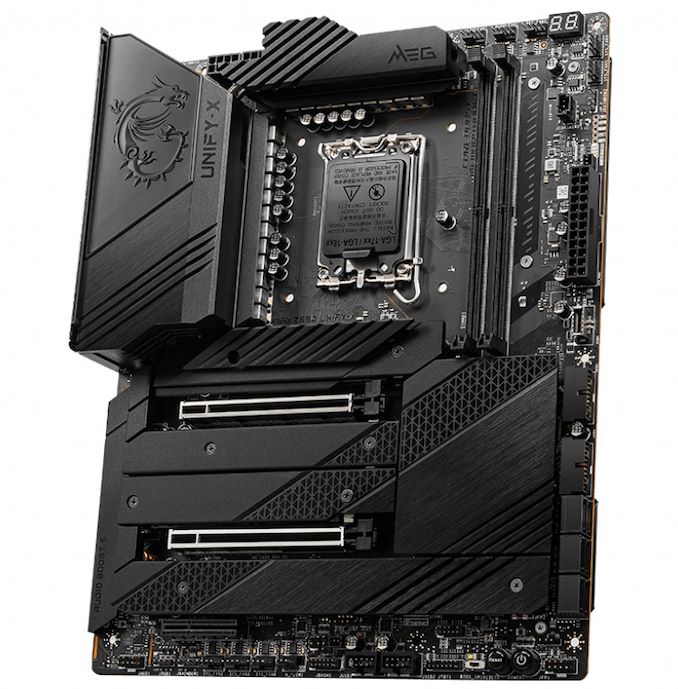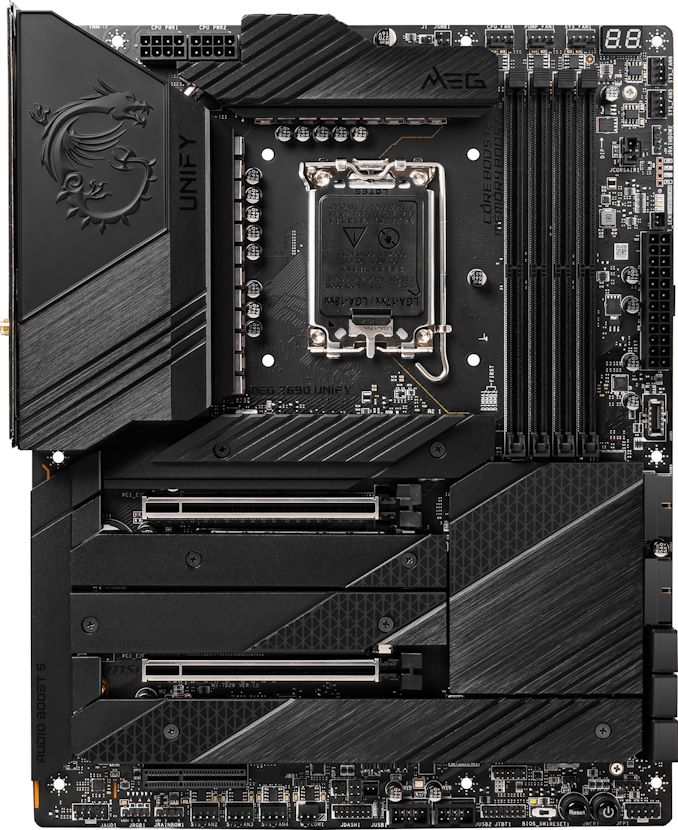The Intel Z690 Motherboard Overview (DDR5): Over 50+ New Models
by Gavin Bonshor on November 9, 2021 9:00 AM ESTMSI MEG Z690 Unify (DDR5) & Z690 Unify X (DDR5)
Sitting below the Godlike and Ace models in MSI's product stack is a pair of Unify branded models. Both the MSI MEG Z690 Unify and Z690 Unify X are a part of the MEG (MSI Enthusiast Gaming) series, with the same core feature set, but with two distinct differences. Aesthetically, both models share the exact same all-black aesthetic we've come to love from the Unify series. This approach was initially marketed as an alternative to RGB clad models, but it has become a solid series for enthusiasts with premium features, good power delivery specifications, and of course, pricing.

The MSI MEG Z690 Unify X with two DDR5-6800 capable memory slots
The MEG Z690 Unify features four memory slots with support for up to 128 GB of DDR5-6666 and is more suitable for gaming, while the MEG Z690 Unify X is aimed at extreme overclockers and enthusiasts with just two memory slots capable of supporting up to 64 GB of DDR5-6800.

The MSI MEG Z690 Unify with four memory slots capable of supporting DDR5-6666
Aside from the obvious differences in memory compatibility and support, both the MEG Z690 Unify and Unify X includes two full-length PCIe 5.0 slots operating at x16 and x8/x8, with a half-length PCIe 3.0 x4 slot. MSI is advertising a large 21-phase power delivery for both models, with both models sharing the same all-black and non-RGB enabled aesthetic, which is sure to please users looking for a more subtle look. Storage options are impressive across both models with four PCIe 4.0 x4 M.2 slots, one PCIe 3.0 x4 M.2 slot, and six SATA ports with support for RAID 0, 1, 5, and 10 arrays.
Both the MSI MEG Z690 Unify and Z690 Unify X are using the same controller set, and as a consequence, the rear panels are exactly the same. On the rear panel of both boards include one USB 3.2 G2x2 Type-C, seven USB 3.2 G2 Type-A, and two USB 2.0 ports. Networking support is strong, with two Intel I225-V 2.5 GbE controllers, and an Intel AX210 Wi-Fi 6E CNVi offering both wireless and BT 5.2 support. MSI hasn't specified the audio controllers, but there are five 3.5 mm audio jacks and a S/PDIF optical output powered by a Realtek ALC4080 HD audio codec. FInishing off the rear panel is a PS/2 combo port, a BIOS flashback button, and a clear CMOS button.











126 Comments
View All Comments
mode_13h - Friday, November 12, 2021 - link
I was really disappointed not to see more discussion of costs and why the price distribution of these boards tends to skew so high.However, I was most surprised to see how much lower some of the entry-level models are priced. Do we think these will be produced in sufficient volume, or are they primarily there as a means of upselling would-be buyers who, out of frustration at seeing them always out-of-stock eventually end up buying one of the more expensive models?
mikk - Saturday, November 13, 2021 - link
MSI Pro Z690-A WIFI, MSI Pro Z690-A and many more have the cheaper Realtek ALC897 Codec, the audio table is not accurate and it says Z490 instead of Z690.ajollylife - Sunday, November 14, 2021 - link
Wtf is with the PCIe 3.0 slots? I'm looking at the Gigabyte Aorus Master, has 10gig onboard, great, but then the other two pcie slots are pcie 3.0 So confused.mode_13h - Sunday, November 14, 2021 - link
From what I've read, PCIe 4.0 tends to require retimers, which adds cost and takes space. Those could be reasons why we don't see more PCIe 4.0 slots.back2future - Monday, November 15, 2021 - link
maybe mainboards start getting reshaped/redesigned (vertical m.2, backside slots/connectors, ?) instead of using retimers (chipset TDP includes retimer power?, cooling power for peripherals on PCIe 5.x speeds on 4GB/(s*lane)=~2 lanes sufficient for fastest available (2021, consumer) SSDs )?ecclesiastes121314 - Wednesday, February 23, 2022 - link
2 ram slots? I've seen this on a few of these new DDR5 boards. Most people here are talking about Thunderbolt 4 and USB4. Yes these are very useful to a select group of people yet these can be achieved with add on cards. Then you can pay for the devices to take advantage of these technologies. Reducing ram slots from 4 to 2. Wow. Yes you can buy high density ram. But this is forcing you that direction. What is wrong with 4x16 or 4x32 ram kits? If you (me) are interested in high performance video then affordable and available ram is a huge consideration. Is it just me?